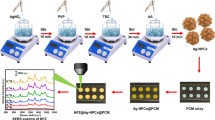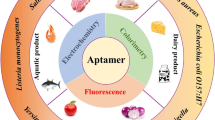Abstract
The authors describe a sensitive surface-enhanced Raman scattering (SERS)-based aptasensor for the detection of the food pathogen Vibrio parahaemolyticus. Nanostructures consisting of Fe3O4@Au particles wrapped with graphene oxide (GO) were used both as SERS substrates and separation tools. A first aptamer (apt 1) was immobilized on the Fe3O4@Au/GO nanostructures to act as a capture probe via the affinity binding of aptamer and V. parahaemolyticus. A second aptamer (apt-2) was modified with the Raman reporter molecule TAMRA to act as a SERS sensing probes that binds to the target the same way as the Fe3O4@Au/GO-apt 1. The sandwich formed between Fe3O4@Au/GO-apt 1/V. parahaemolyticus and apt 2-TAMRA can be separated with the aid of a magnet. The concentration of V. parahaemolyticus can be quantified by measurement of the SERS intensity of TAMRA. Under optimal conditions, the signal is linearly related to the V. parahaemolyticus concentration in the range between 1.4 × 102 to 1.4 × 106 cfu·mL−1, with a detection limit of 14 cfu·mL−1. Recoveries ranging from 98.5% to 105% are found when analyzing spiked salmon samples. In our perception, the assay described here is a useful tool for quantitation of V. parahaemolyticus in real samples.

GO wrapped Fe3O4@Au nanostructures were synthesized as the substrate and modified with with a first aptamer (apt 1) to capture V. parahaemolyticus. TAMRA labelled aptamer 2 was then used as signal probe. The V. parahaemolyticus concentrations are closely related to the Raman intensity of TAMRA.





Similar content being viewed by others
References
Banholzer MJ, Millstone JE, Qin L, Mirkin CA (2008) Rationally designed nanostructures for surface-enhanced Raman spectroscopy. Chem Soc Rev 37:885–897
Betz JF, Yu WW, Cheng Y, White LM, Rubloff GW (2014) Simple SERS substrates: powerful, portable, and full of potential. Phys Chem Chem Phys 16:2224–2239
Stranahan SM, Willets KA (2010) Super-resolution optical imaging of single-molecule SERS hot spots. Nano Lett 10:3777–3784
Chen JW, Liu XP, Feng KJ, Liang Y, Jiang JH, Shen GL, Yu RQ (2008) Detection of adenosine using surface-enhanced Raman scattering based on structure-switching signaling aptamer. Biosens Bioelectron 24:66–71
Cialla D, Marz A, Bohme R, Theil F, Weber K, Schmitt M, Popp J (2012) Surface-enhanced Raman spectroscopy (SERS): progress and trends. Anal Bioanal Chem 403:27–54
Xie LM, Ling X, Fang Y, Zhang J, Liu ZF (2009) Graphene as a substrate to suppress fluorescence in resonance Raman spectroscopy. J Am Chem Soc 131:9890–9891
Chen P, Yin ZY, Huang X, Wu SX, Liedberg B, Zhang H (2011) Assembly of graphene oxide and au 0.7 Ag 0.3 alloy nanoparticles on SiO2 a new Raman substrate with ultrahigh signal-to-background ratio. J Phys Chem C 115:24080–24084
Xu JH, Wang YZ, Hu SS (2017) Nanocomposites of graphene and graphene oxides: synthesis, molecular functionalization and application in electrochemical sensors and biosensors. A review. Microchim Acta 184:1–44
Hou H, Wang P, Zhang J, Li CP, Jin YD (2015) Graphene oxide-supported Ag nanoplates as LSPR tunable and reproducible substrates for SERS applications with optimized sensitivity. ACS Appl Mater Interfaces 7:18038–18045
Xiao DL, Lu T, Zeng R, YP BI (2016) Preparation and highlighted applications of magnetic microparticles and nanoparticles: a review on recent advances. Microchim Acta 183:2655–2675
Liu ZG, Wang Y, Deng R, Yang LY, Yu SH, Xu SP, Xu WQ (2016) Fe3O4@graphene oxide@Ag particles for surface magnet solid-phase extraction surface-enhanced raman scattering (SMSPE-SERS): from sample pretreatment to detection all-in-one. ACS Appl Mater Interfaces 8:14160–14168
Jarvis RM, Goodacre R (2004) Discrimination of bacteria using surface enhanced Raman spectroscopy. Anal Chem 76:40–47
Mungroo NA, Oliveira G, Neethirajan S (2016) SERS based point-of-care detection of food-borne pathogens. Microchim Acta 183:697–707
Knauer M, Ivleva NP, Niessner R, Haisch C (2012) A flow-through microarray cell for the online SERS detection of antibody-captured E. coli bacteria. Anal Bioanal Chem 402:2663
Drake P, Jiang PS, Chang HW, Su SC, Tanha J, Tay LL, Chen PL, Lin YJ (2013) Raman based detection of Staphylococcus aureus utilizing single domain antibody coated nanoparticle labels and magnetic trapping. Anal Methods 5:4152–4158
Lin YF, Hamme AT (2014) Targeted highly sensitive detection/eradication of multi-drug resistant Salmonella DT104 through gold nanoparticle-SECNT bioconjugated nanohybrids. Analyst 139:3702–3705
Cho IH, Bhandari P, Patei P, Irudayaraj J (2015) Membrane filter-assisted surface enhanced Raman spectroscopy for the rapid detection of E. coli O157:H7 in ground beef. Biosens Bioelectron 64:171–176
Ellington AD, Szostak JW (1990) In vitro selection of RNA that bind specific ligands. Nature 346:818–822
Tuerk C, Gold L (1990) Systematic evolution of ligands by exponential enrichment: RNA ligands to bacteriophage T4 DNA polymerase. Science 249:505–510
Nimjee SM, Rusconi CP, Sullenger BA (2005) Aptamers: an emerging class of therapeutics. Annu Rev Med 56:555–583
Wang JF, Wu XZ, Wang CW, Shao NS, Dong PT, Xiao R, Wang SQ (2015) Magnetically assisted surface-enhanced raman spectroscopy for the detection of Staphylococcus aureus based on aptamer recognition. ACS Appl Mater Interfaces 7:20919–20929
Duan N, Yan YL, Wu SJ, Wang ZP (2016) Vibrio parahaemolyticus Detection aptasensor using surface-enhanced Raman scattering. Food Control 63:122–127
Duan N, Chang BY, Zhang H, Wang ZP, Wu SJ (2016) Salmonella typhimurium detection using a surface-enhanced Raman scattering-based aptasensor. Int J Food Microbiol 218:38–43
Zhang H, Ma XY, Liu Y, Duan N, Wu SJ, Wang ZP, Xu BC (2015) Gold nanoparticles enhanced SERS aptasensor for the simultaneous detection of Salmonella typhimurium and Staphylococcus aureus. Biosens Bioelectron 74:872–877
Duan N, Wu SJ, Chen XJ, Huang YK, Wang ZP (2012) Selection and identification of a DNA aptamer targeted to Vibrio parahaemolyticus. J Agric Food Chem 60:4034–4038
Deng H, Li XL, Peng Q, Wang X, Chen JP, Li YD (2005) Monodisperse magnetic single-crystal ferrite microspheres. Angew Chem Int Ed 44:2782–2785
Ding GH, Xie S, Zhu YM, Liu Y, Wang L, Xu FG (2015) Graphene oxide wrapped Fe3O4@au nanohybrid as SERS substrate for aromatic dye detection. Sensors Actuators B: Chem 221:1084–1093
Acknowledgements
This work was partly supported by the natural science foundation of Jiangsu Province BK20140155, Key Research and Development Program of Jiangsu Province BE2016306, the National Natural Science Fund of China (NSFC 31401575, 31401576), China Postdoctoral Science Foundation (2016 T90430), and Collaborative innovation center of food safety and quality control in Jiangsu Province.
Author information
Authors and Affiliations
Corresponding authors
Ethics declarations
The author(s) declare that they have no competing interests.
Electronic supplementary material
ESM 1
(DOCX 116 kb)
Rights and permissions
About this article
Cite this article
Duan, N., Shen, M., Wu, S. et al. Graphene oxide wrapped Fe3O4@Au nanostructures as substrates for aptamer-based detection of Vibrio parahaemolyticus by surface-enhanced Raman spectroscopy. Microchim Acta 184, 2653–2660 (2017). https://doi.org/10.1007/s00604-017-2298-9
Received:
Accepted:
Published:
Issue Date:
DOI: https://doi.org/10.1007/s00604-017-2298-9




